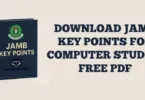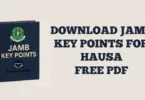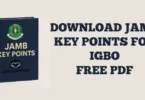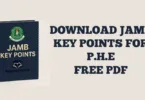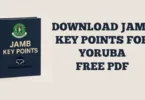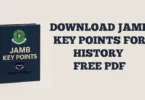Download JAMB Music Past Questions Free 2024:- JAMB Music may seem like a fun and creative subject, but don’t let that fool you—it still requires serious preparation. Music in JAMB tests both theoretical knowledge and practical skills, covering areas like music theory, history, composition, and music analysis. One of the best ways to prepare is by solving past questions. In this guide, I’ll show you how to download JAMB Music past questions for free, why they are essential for your success, and how to use them effectively for the 2024 exam.
Download JAMB Music Past Questions Free 2024
Here are 20 sample multiple-choice (OBJ) JAMB Music past questions for practice:
1. Which of the following is an example of a musical instrument in the string family?
A) Trumpet
B) Violin
C) Drum
D) Saxophone
2. The term “tempo” in music refers to:
A) The speed at which a piece of music is played
B) The loudness or softness of the music
C) The arrangement of chords in a piece
D) The number of beats in a measure
3. Which of the following is a wind instrument?
A) Piano
B) Trumpet
C) Flute
D) Guitar
4. Which musical symbol indicates a pause or break in music?
A) Crescendo
B) Fermata
C) Staccato
D) Legato
5. What is the primary function of a conductor in an orchestra?
A) To play the lead instrument
B) To write the music
C) To lead the orchestra and direct the performance
D) To arrange the music
6. Which of the following time signatures is common in 4/4 time music?
A) 3/4
B) 2/4
C) 4/4
D) 6/8
7. The term “dynamics” in music refers to:
A) The pitch of the music
B) The quality of sound
C) The speed of the music
D) The loudness or softness of the music
8. Which of the following is a key component in the structure of Western classical music?
A) Chord progression
B) Verse-chorus form
C) Thematic development
D) Beatboxing
9. The “staff” in music notation consists of how many lines?
A) 5
B) 7
C) 8
D) 6
10. Which of the following musical scales contains the notes C, D, E, F, G, A, B, and C?
A) Major scale
B) Minor scale
C) Pentatonic scale
D) Chromatic scale
11. The term “harmony” in music refers to:
A) A melody that is sung or played in unison
B) A single musical note played in isolation
C) The combination of different musical notes played simultaneously
D) The rhythm of the music
12. Which of the following is an example of an African traditional musical instrument?
A) Trombone
B) Djembe
C) Violin
D) Cello
13. The musical term “allegro” refers to:
A) A slow tempo
B) A fast tempo
C) A smooth connection between notes
D) A loud dynamic level
14. Which of the following best defines the term “melody”?
A) A repeated rhythmic pattern
B) A sequence of notes that are perceived as a single entity
C) The combination of multiple harmonies
D) A musical rest
15. A “treble clef” is used to notate the higher range of instruments and voices. Which instrument primarily uses the treble clef?
A) Bass guitar
B) Flute
C) Timpani
D) Cello
16. In Western classical music, the “overture” is generally performed:
A) At the end of a performance
B) Before the main performance begins
C) As a musical interlude during the performance
D) After each movement
17. The primary difference between a “sharp” and a “flat” note in music is that:
A) A sharp note is played lower than a natural note, while a flat note is played higher
B) A sharp note raises the pitch, while a flat note lowers it
C) A sharp note is louder than a flat note
D) A sharp note is used in classical music, while a flat note is used in modern music
18. What is the “key signature” in music notation?
A) The set of musical notes that define the key of a piece
B) The tempo of the piece
C) The volume of the music
D) The time signature of the piece
19. Which of the following is a genre of music that originated in the United States in the early 20th century, blending elements of African and European musical traditions?
A) Jazz
B) Rock
C) Classical
D) Reggae
20. Which of the following is the correct order of the strings on a violin (from lowest to highest)?
A) G, D, A, E
B) E, A, D, G
C) C, G, D, A
D) E, D, G, A
Why JAMB Music Past Questions Are Essential
Practicing with past questions is one of the most effective ways to excel in JAMB Music. Here’s why:
- Familiarity with Exam Structure
JAMB Music questions cover a wide range of topics, from music theory to the history of music. By practicing past questions, you’ll get used to how questions are asked—whether it’s identifying musical terms, analyzing a piece of music, or understanding the evolution of different music genres. This helps you feel more confident when you see similar questions in the actual exam. - Spot Key Topics
JAMB Music often focuses on certain themes and topics, such as musical instruments, music theory, types of scales, notational systems, famous composers, and music history. Past questions help you identify recurring topics, so you can focus your study efforts on what matters most. - Improve Speed and Confidence
Music questions can range from theoretical analysis to listening exercises. The more you practice past questions, the more you’ll develop your speed in solving them while maintaining accuracy. It also helps build your confidence since you’ll be familiar with the type of questions that come up in the exam.
Where to Find Free JAMB Music Past Questions for 2024
Here are some trusted platforms where you can download free JAMB Music past questions:
- JAMB Official Website
The official JAMB website provides authentic past questions for all subjects, including Music. Although the selection may be limited, they are reliable and up-to-date with the current syllabus. - Pass.ng
Pass.ng is one of the most popular platforms for JAMB preparation. They offer free downloads of past questions, including for Music, and provide detailed explanations for each answer, helping you better understand the reasoning behind the correct responses. - Examplaza.ng
Examplaza is another excellent source for downloading free JAMB Music past questions. Their collection is regularly updated to ensure the content is relevant to the 2024 exam. - EkoBrain
EkoBrain is also a reliable platform for downloading past questions for JAMB Music. They provide a variety of questions and keep their resources up-to-date, so you’re always practicing with the most current materials.
How to Download JAMB Music Past Questions for Free
Downloading JAMB Music past questions is simple. Here’s how:
- Visit a Trusted Platform
Head to reliable platforms like Pass.ng, Examplaza.ng, or EkoBrain. - Select the Year (2024) and Subject (Music)
Choose 2024 as the exam year and Music as your subject from the available options. - Click the Download Link
Once you’ve selected the correct subject and year, click the download button. Some sites may ask for your email address to send you the download link directly. - Save the Questions
After downloading, save the past questions in a folder that’s easy to access. Organize them by year or topic for quick reference when studying. - Start Solving
Now that you have the past questions, start practicing! Treat each one like it’s the real exam to get the most out of your practice.
How to Use JAMB Music Past Questions Effectively
Simply downloading the past questions won’t be enough—you need to practice them strategically to make the most out of your preparation. Here’s how:
- Simulate Real Exam Conditions
Set a timer when solving past questions to mimic the actual exam setting. This will help you improve your time management and allow you to gauge how quickly you can answer each question, which is essential for success in the exam. - Focus on Core Music Theory
JAMB Music often tests key areas such as scales, time signatures, chords, and musical notation. Be sure to practice these topics thoroughly. Past questions will help you identify which areas you struggle with and need to work on more. - Analyze Musical Pieces
Some questions will ask you to analyze music pieces or identify certain aspects like dynamics, tempo, or instrumentation. Practice this by analyzing different musical excerpts, and get comfortable with musical terminology such as forte, piano, crescendo, etc. - Review Mistakes
Whenever you get a question wrong, take the time to review it and understand why your answer was incorrect. Understanding your mistakes is one of the most efficient ways to improve. - Use Multiple Resources
Combine your past question practice with textbooks, study guides, and online music theory resources. A deeper understanding of theory, history, and composers will help you answer questions more accurately and confidently.
Additional Tips to Excel in JAMB Music
Here are a few extra tips that will give you an edge in your JAMB Music preparation:
- Master Music Terminology
Knowing the terms used in music theory, instrumentation, composition, and history is essential. Ensure you understand musical scales, notation, and famous musical forms such as sonata, symphony, and opera. These terms frequently appear in JAMB questions. - Understand the History of Music
JAMB Music questions often test your knowledge of music history, including important periods (e.g., Baroque, Classical, Romantic) and key composers (e.g., Beethoven, Mozart, Chopin). Study the historical evolution of music and the significant contributions of different artists. - Practice Sight-Reading
Sight-reading is an essential skill in music exams. Practicing reading sheet music and identifying notes, intervals, and rhythms will improve your ability to answer related questions quickly. - Stay Consistent with Practice
Set aside a dedicated time each day or week to practice. Consistent practice with past questions will help reinforce your knowledge and increase your retention. - Listen to Music Actively
Listening to different genres and pieces of music actively can help you identify various musical elements like melody, harmony, and rhythm. You can find resources online that break down pieces of music for educational purposes.
Maximizing Your Free JAMB Music Past Questions Download
To get the most out of your past question downloads, here are some strategies:
- Combine Free with Paid Resources
While free past questions are great, investing in paid study materials, like advanced textbooks or apps, can provide more in-depth practice and detailed explanations. - Track Your Progress
Use tools like Google Sheets or Trello to track how many questions you’ve solved, which topics you’ve covered, and where you need improvement. This helps you stay organized and ensures you’re revising systematically. - Use Music Apps
Download apps like JAMB Exam Prep 2024 to practice Music questions on the go. These apps are designed to simulate the real exam conditions and help you track your progress, making it easier to prepare on the move.
Conclusion
JAMB Music may be a creative subject, but it requires focused preparation and consistent practice. By downloading and solving JAMB Music past questions, you’ll gain a better understanding of the exam format, familiarize yourself with key topics, and improve your time management. Stay consistent, focus on core areas, and use your mistakes as learning opportunities. With the right preparation, you’ll be ready to excel in the 2024 exam. Best of luck with your studies!
Recommended Post
- Download JAMB Chemistry Past Questions Free 2024
- Download JAMB Physics Past Questions Free 2024
- Download JAMB Biology Past Questions Free 2024
- Download JAMB Yoruba Past Questions Free 2024
- Download JAMB Mathematic Past Questions Free 2024
- Download JAMB English Past Questions Free 2024
- Download JAMB Further Maths Past Questions Free 2024
- Download JAMB Government Past Questions Free 2024
- Download JAMB Economics Past Questions Free 2024
- Download JAMB Lit. In English Past Questions Free 2024
- Download JAMB Music Past Questions Free 2024
- How Much Is EKSU Acceptance Fee for 2025/2026 ?

